STEPPING INTO SPRING
/2 Comments/in Gardening, Pests, Vegetables/by Lee ReichCleanup Time Re-Starts in Veggie Garden
Warmer weather, even if it’s not all that warm, makes me feel like spring is just around the corner. The ground — in my vegetable beds, at least — isn’t even frozen, no doubt because water doesn’t linger long in the well-drained soil and because the dark-colored compost blanket I laid down in autumn sucks up the sun’s warmth.
So yesterday seemed like a perfect time to continue the garden cleanup that screeched to a halt when frigid weather struck, and some snow fell, a couple of months ago. Old cabbage heads that never quite ripened were laying on the ground like ratty, pale green tennis balls (with stalks attached). The four-foot-high stalk of one Brussels sprouts plant, stripped in autumn of its sprouts, stood sentry like a decrepit soldier in the same bed.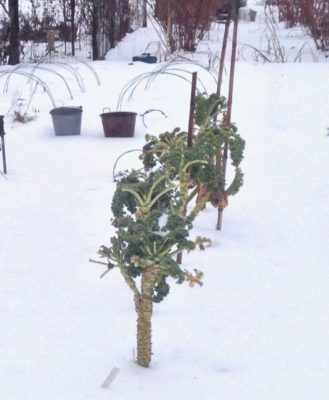
Of course, kale also still stood, except for those that flopped to the ground under their own weight. The latter were mostly the variety Tuscan (Lanciata). The Dwarf Blue Scotch plants, which I think taste better, stood more upright and compact, helped along, I’ll admit, with some bamboo stakes pushed into the ground next to them back in summer. I dug up the Tuscan kale plants and stripped yellowed and flaccid leaves from the Dwarf Blue Scotch plants. My guess is that by April they’ll be unfolding new, tasty leaves.
Stepping over to another bed, I twisted or coaxed out, with the help of my Hori-Hori knife, stumps from harvested lettuce and Chinese cabbage. A row of arugula in that bed showed enough life to awaken in spring with fresh, new leaves. I left it.
All this cleanup gets a jump on spring and removes debris that might harbor insect or disease pests that could infest or infect this season’s plants. The debris went into my garden cart and thence to the compost pile. The winter pile doesn’t heat up, so I’ll give the bacteria, fungi, actinomycetes, and earthworms two years to get their jobs done, killing off any “bad guys.”
Cursed Voles!
Stepping over to the remains of the endive bed that I planted towards the end of last summer and began harvesting in October — what havoc has been wreaked!
The bed had been covered with a tunnel of clear plastic and row cover to provide extra warmth to the plants in cold weather. Extra warmth also to some furry creatures, it seems.
Taking off the cover, I saw a bed riddled with tunnels along with the scattered remains of unharvested endive plants. This has happened in the past; something about endive seems particularly attractive to the furry creatures (and to me), which I assume are voles, which are mouse-like creatures.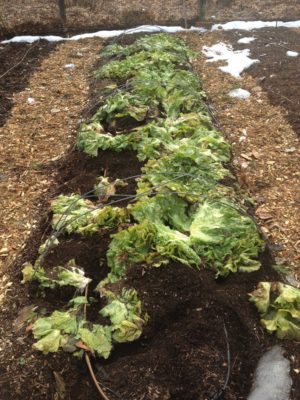
My garden must be vole heaven. The cat rarely hops the garden fence to hunt because she has to cross the DMZ zone to get to the garden, and she’s scared of our dog, Sammy. The compost-enriched soil has plenty of earthworm for good eating, as well as all the tasty, organic produce. So far, though, the voles have been satisfied with just the endive.
Short of planting the cat in the garden, which Sammy can’t enter, my plan is to do extensive trapping. One web site recommendation for a small garden is for twelve traps baited with oatmeal and peanut butter, or with apple.
As consolation, vole populations are said to decline after 3 to 5 years. It’s almost time, although the declined population might still be too many for me. And all is not bad with voles; they help stir the soil to distribute nutrients.
Pre-Season Warmup
While in the garden, I also did some pre-season weeding. Creeping Charlie, which enjoys cool weather, is always sneaking in here and there once I turn my attention away from the garden.
All this garden cleaning and straightening up isn’t all for practicality. It makes the view of the garden each morning from my second floor bedroom window prettier.
OF FLOWERS AND TEMPERATURES
/4 Comments/in Gardening, Houseplants, Tools/by Lee ReichFlower, You Hoya
I probably shouldn’t admit this, but some plants suffer much neglect in my hands. My aloe, for example, has occasionally gone a whole year without a drop of water.
Hoya, also known as wax plant or Hindu rope plant, is another of my neglected plants. This plant is about 25 years old and has sat in the same pot in the same location for the past 15 years. The pot is only 3 inches square, dwarfed by the 3-foot-long “Hindu rope,” a single stem along which grow thick, green, involuted leaves. The hoya sits on a west-facing windowsill of a tower window in my house, and the lanky stem can drip down another 2 to 3 feet before it’s got to be shortened to keep from being bumped by anybody beneath it. One reason the plant gets watered so infrequently is because watering involves pulling out and climbing a ladder stairway to get to and gingerly water the relatively small pot.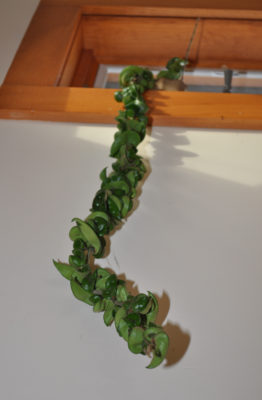
Another reason for the neglect is because hoya is a succulent whose thick fleshy leaves store water. The plant is more likely to die from too much water than too little.
Although I occasionally glance admiringly at the stem tracing down the wall, there are time periods when hoya grabs my attention. That’s when it flowers. The flowers arise in sprays of about a dozen, pinkish, tubular blossoms, each looking as if has been sculpted from wax. Not only are these flowers pretty, but they also emit the most delicious aroma of chocolate.
I’m not sure when or why my hoya flowers. Failure to bloom can be attributed to, according to reliable sources, “over-watering, over fertilization, insufficient sunlight, or plant immaturity. “ Ha! My guess is that a period of consistent, but not excessive, watering following the dry spells would coax the plant to flower. Now might be the time to start watering because, perhaps in celebration of lengthening days, the plant has, after all these years, sprouted a new shoot.
I’ll go and water the hoya right this minute.
And The Temperature Is . . . ?
“You never miss the water till the well runs dry,” goes the line from the old blues tune. In the same vein, you — or I, at least — never miss the thermometer till it breaks. I never realized how tied I was to the temperature until the number boxes on my digital thermometer started reading “- – – – -.”
Thermometers have come a long way since the liquid-in-glass ones that served so well for so many years mounted outside so many kitchen windows or on porch posts. You had to get close to read them, and they picked up some heat from proximity to the house.
After that came indoor-outdoor ones, using the same principal but with two glass columns. The “outdoor” column is fed by a thin tube threaded through a small hole in a window frame and ending with a sensing bulb. These thermometers let you essentially get your eyes further from the sensing portion.
Then came digital versions of both types of liquid-in-glass thermometers. Digital thermometers are just the ticket for those of us who like to know if the temperature is 31.4° F. or 32.2° F. Not that the sensors of these thermometers were necessarily accurate to 0.1° F (as stated, sometimes, in the fine print), but they did give a feeling of exactitude.
Still, all these thermometers measure temperatures in or near the house, unless you mounted one on a post out in the garden and kept running out to check the temperature. Or, you had a liquid-in-glass thermometer that registered the minimum and maximum temperatures since the last reading. As you might guess, I have one, have had it for over 30 years, in fact. Two sliding, iron indicators are pushed by the expanding fluid, with one indicator staying where it is pushed to its high point, the other to its low point. High and low temperatures are indicated for the period since the sliders were last reset by being slid back with a magnet against the fluid. Very elegant and very accurate, but you still have to run out to the garden to read the present temperature.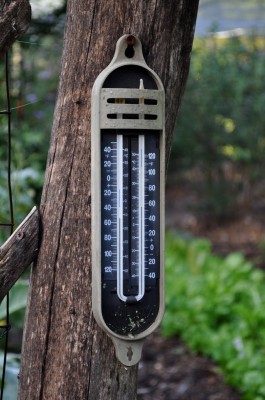
Enter wireless, digital, minimum-maximum thermometers, the ultimate in temperature readiness. With this thermometer (which, as you might have again guessed, I own), I can read present and extreme temperatures from the warmth of my bedroom. Except when they stop working. Then you really miss knowing the temperature to within a tenth of a degree.
Epilogue
Epilogue: Yes, I checked and changed the batteries. Customer support, last time I got through to them, tells me I have to use fresh batteries, not the rechargeable ones. And I have to take all the batteries out for 15 minutes. Then, while the outdoor and indoor sensors are 3 to 5 ft. apart, I have to first put in the outdoor sensor’s batteries, followed by the indoor sensor’s batteries, and let the sensors “communicate” for 20 minutes. Etc., etc. The thermometer still doesn’t work. Perhaps I should click my heals together three times. I bought a new, and, I hope, better one.
THE WEATHER WON’T PUSH ME AROUND
/5 Comments/in Fruit, Gardening, Planning, Pruning, Vegetables/by Lee ReichBreaking (Pruning) Rules
Snow squall or not, I just had to get outside. Not enough snow for a cross-country ski, but, after too much time indoors, I had to do something outside.
I was driven to break a fundamental rule of the garden. I pruned, and that’s a no-no. Pruning is best delayed until at least after the coldest part of winter is over, ideally closer to the time when warmth and sun are stirring buds to swell in preparation for their final burst. I did rationalize that any pruning now would leave me that much less to do amidst the hubbub of spring gardening activities.
I wasn’t indiscriminate in trespassing this Rule of Gardening. The plants that I pruned were gooseberries, which are very cold-hardy plants so are unlikely to suffer any cold damage as a result of untimely pruning. Also, no need to wait, as is done with peaches, for growth to begin to see which branches have died back from winter cold; none ever do so on a gooseberry bush.
Pruning without spring breathing down my back made for a very relaxed pruning session. I had plenty of time to pay attention to details and prune a little differently than in the past.
Gooseberries bear fruits on stems that are 1-, 2-, and 3-years-old, so the usual method of pruning is to cut away any stems more than 3-years-old and remove all but six of the sturdiest 1-year-old stems. The pruned bush, then, is left with a half-dozen each of 1-, 2-, and 3-year old stems. Each year a bush is renewed as oldest stems are removed, and new grow kept vigorous and healthy as excess young stems are thinned out.
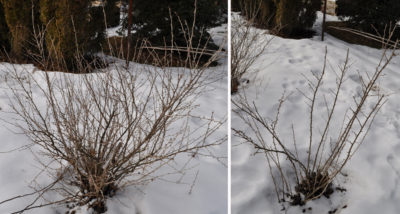
Gooseberry before & after pruning
The gooseberry bushes always bear many more berries than we can eat, and their weight bows the branches to the ground. So this year I decided to also prune each side branch on the older stems back to a couple of inches long. I’ll reap fewer berries, but those that remain should be larger and more accessible among the thorny stems.
Great Gooseberries
Is it worth mentioning such details about growing gooseberries? After all, who eats gooseberries these days? To most people, a gooseberry is a small, green, tart berry suitable only for pies, jams, and fools (a dessert made by folding cooked, sweetened, sieved gooseberries into whipped cream).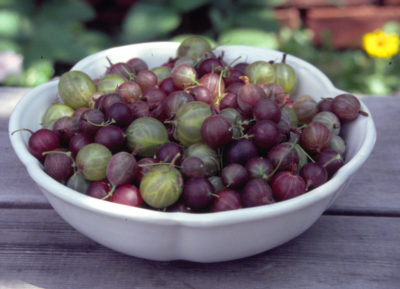
If small, green, and tart is your idea of a gooseberry, you’ve never tasted a so-called dessert gooseberry. Dessert gooseberries are sweet and flavorful right off the bush; they are, as Edward Bunyard wrote almost a hundred years ago in The Anatomy of Dessert, “the fruit par excellence for ambulant consumption.” (He was from England, where gooseberries are more appreciated and known than here.)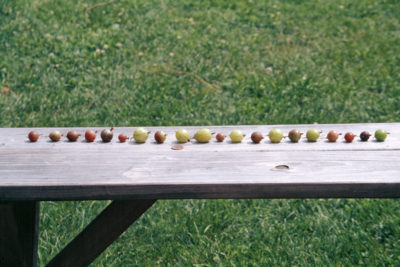
Only certain gooseberry varieties warrant the label “dessert gooseberry,’ of which I grow about a dozen varieties. My favorites include Hinonmakis Yellow, Poorman, Black Satin, Webster, Red jacket, and Captivator. Their sweet flavors carry wine-y overtones and reminiscences of plum or apricot. Some have soft skins, others have firm skins that explode with the flavorful, sweet juice when you bite into them. I devote a whole chapter to the history and varieties of gooseberries as well as how to grow them and where to get them in my book Uncommon Fruits for Every Garden (available from the usual sources and, from me and signed, at my website).
Back Indoors, But Still Gardening
Frozen fingertips eventually drove me back indoors. But I’m now on a gardening roll, spurred on further by a box of seed packets that arrived in the mail.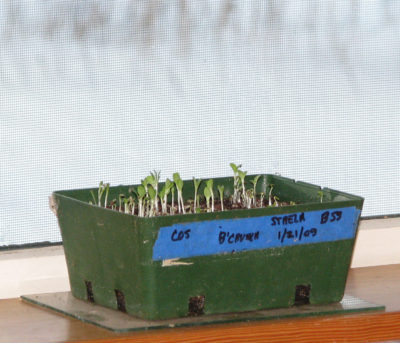
Lettuce, claytonia, and celery from the greenhouse have been filling our salad bowls all winter. As these plants wane or go to seed, we’ll need more. So today I sowed seeds of Black-Seeded Simpson, Romaine, Buttercrunch, Blushed Butter Cos, and Majestic Red lettuces. Some I sprinkled into seed flats that can be kept warm for quick germination. Some I sowed right in the ground beds in the greenhouse; they’ll germinate more slowly but hold their quality longer than those that are pricked out from seed flats into “cells” and then into the garden.
Sometime soon, I’ll grab my pruning shears and get back to the gooseberries. And then on to the grapes, the kiwis, the apples, the pears, the . . .

